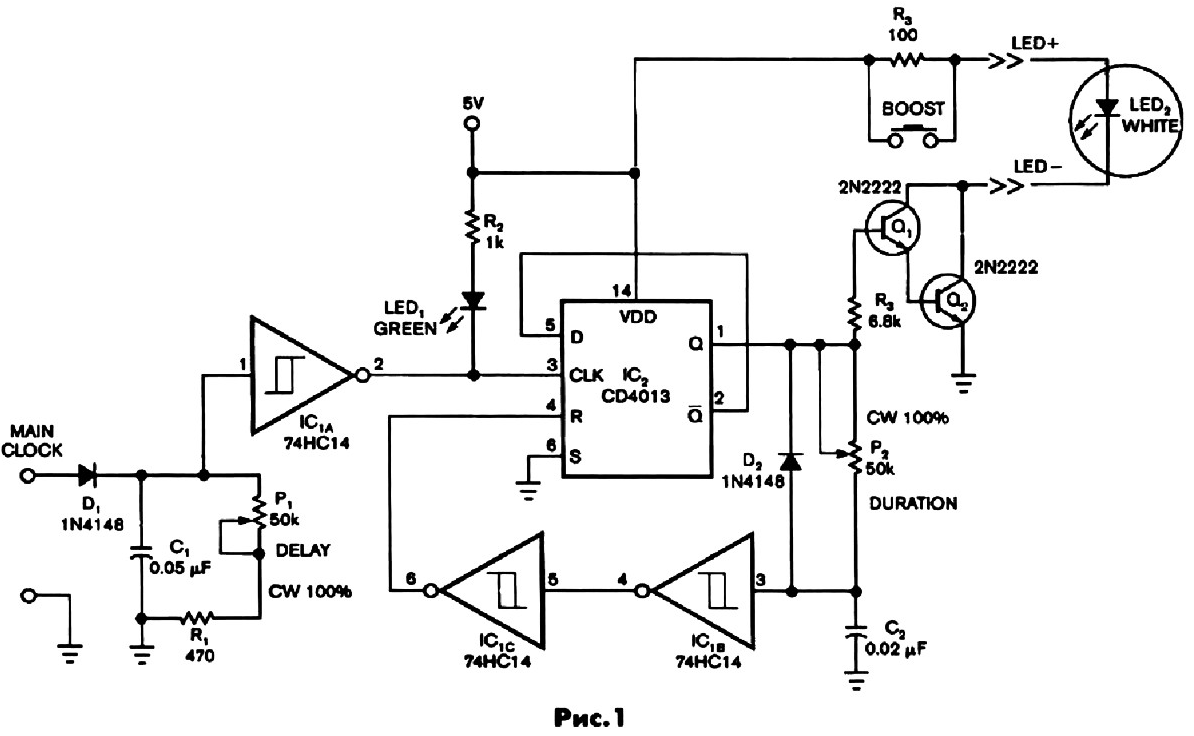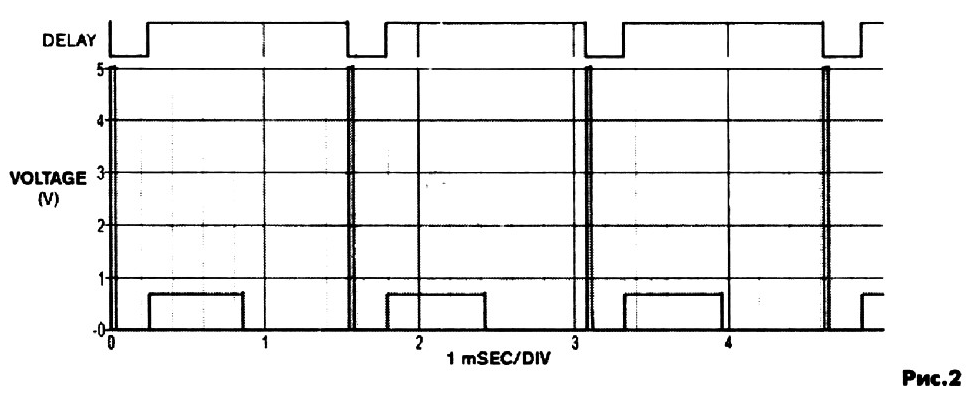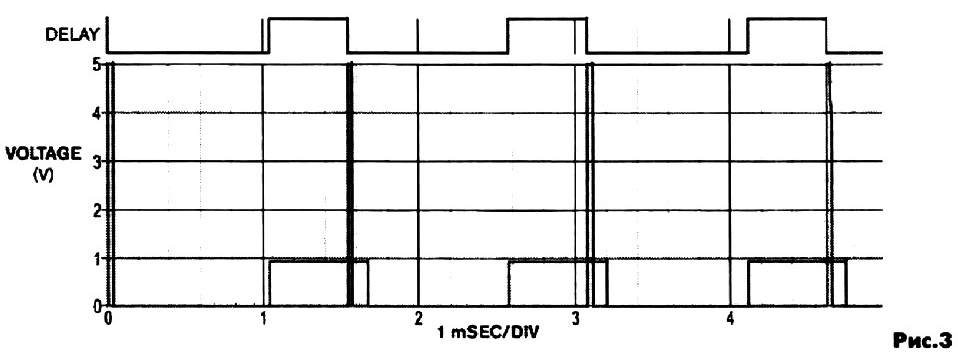LED strobe light with adjustable delay and duration. Encyclopedia of radio electronics and electrical engineering

Encyclopedia of radio electronics and electrical engineering / Automobile. Ignition
 Comments on the article
Comments on the article
The device contains a MAIN CLOCK clock input for supplying a clock signal and an ultra-bright white LED output. The delay and duration of the LED glow are regulated by potentiometers P1 and P2. The circuit uses a universal green LED 1 to indicate the presence of an input signal, although this LED is useless when the stroboscope is operating at high frequencies.
Figure 1 shows a diagram of an LED stroboscope.

(click to enlarge)
A pulse signal with an amplitude of 5 V and a duration of approximately 30 μs is supplied to the input of the stroboscope from the vehicle's fuel pump. In this case, the potentiometer P1 regulates the delay time of the LED flashes in the range from 40 μs to 2 ms, and the potentiometer P2 regulates the duration of the glow (or flash) of the LED from 15 μs to 15 ms.
Diode D1 and capacitor C1 form a forming circuit. The discharge rate of the capacitor C1 is regulated by setting the potentiometer P1. The inverting Schmitt trigger IC 1A monitors the voltage level on the capacitor C1. As soon as the voltage reaches the low threshold of the 1C 1A trigger, a high level appears at its output, which is transmitted to the clock input of the D-flip-flop IC2. The Q output is set high. The Darlington pair of transistors Q1 and Q2 opens, current flowing through the bright white LED causes it to glow.
At this time, the capacitor C2 is charging, the charge rate is adjusted by the potentiometer P2. When the voltage on the capacitor reaches the upper threshold of the inverting Schmitt trigger IC1 B, the D-trigger IC1 will be reset through the 1C 2C trigger and its output Q will go high. The transistor pair closes and the white LED goes out. The circuit is now ready for another cycle.
Diode D2 provides a complete discharge of the capacitor C2.
Figure 2 shows process diagrams. 5 V clock input at 650 Hz. The upper curve of the graph shows the voltage on the white LED, the delay is about 250 µs (at P1 -10%) and the duration of the glow is approximately 600 µs (at P2 - 75%). The bottom trace shows the voltage at the Q output of D-flip-flop IC2.

(click to enlarge)
Fig. 3 shows diagrams with a different delay time for the same duration of the white LED (Fig. 2). The new fuel spray period overlaps the next fuel burst. Depending on the injector nozzle, one can observe the end of one calibrated flash of the fuel mixture and the beginning of another.

(click to enlarge)
The stroboscope is equipped with a switch to instantly increase the intensity (with resistance R3, the current through the LED is approximately 40 mA). When the BOOST button is pressed, a current of approximately 2 mA flows through the Darlington pair of 2222N400 transistors, i.e. Continued use of the switch may cause the white LED to fail.
Time intervals can be calculated using the formula: T = 0,7 x R x C, where T is the time in seconds, R is the resistance in ohms and C is the capacitance in farads.
Author: M.Page
 See other articles Section Automobile. Ignition.
See other articles Section Automobile. Ignition.
 Read and write useful comments on this article.
Read and write useful comments on this article.
<< Back
 Latest news of science and technology, new electronics:
Latest news of science and technology, new electronics:
Solidification of bulk substances
30.04.2024
There are quite a few mysteries in the world of science, and one of them is the strange behavior of bulk materials. They may behave like a solid but suddenly turn into a flowing liquid. This phenomenon has attracted the attention of many researchers, and we may finally be getting closer to solving this mystery. Imagine sand in an hourglass. It usually flows freely, but in some cases its particles begin to get stuck, turning from a liquid to a solid. This transition has important implications for many areas, from drug production to construction. Researchers from the USA have attempted to describe this phenomenon and come closer to understanding it. In the study, the scientists conducted simulations in the laboratory using data from bags of polystyrene beads. They found that the vibrations within these sets had specific frequencies, meaning that only certain types of vibrations could travel through the material. Received ... >>
Implanted brain stimulator
30.04.2024
In recent years, scientific research in the field of neurotechnology has made enormous progress, opening new horizons for the treatment of various psychiatric and neurological disorders. One of the significant achievements was the creation of the smallest implanted brain stimulator, presented by a laboratory at Rice University. Called Digitally Programmable Over-brain Therapeutic (DOT), this innovative device promises to revolutionize treatments by providing more autonomy and accessibility to patients. The implant, developed in collaboration with Motif Neurotech and clinicians, introduces an innovative approach to brain stimulation. It is powered through an external transmitter using magnetoelectric power transfer, eliminating the need for wires and large batteries typical of existing technologies. This makes the procedure less invasive and provides more opportunities to improve patients' quality of life. In addition to its use in treatment, resist ... >>
The perception of time depends on what one is looking at
29.04.2024
Research in the field of the psychology of time continues to surprise us with its results. Recent discoveries by scientists from George Mason University (USA) turned out to be quite remarkable: they discovered that what we look at can greatly influence our sense of time. During the experiment, 52 participants took a series of tests, estimating the duration of viewing various images. The results were surprising: the size and detail of the images had a significant impact on the perception of time. Larger, less cluttered scenes created the illusion of time slowing down, while smaller, busier images gave the feeling of time speeding up. Researchers suggest that visual clutter or detail overload can make it difficult to perceive the world around us, which in turn can lead to faster perception of time. Thus, it was shown that our perception of time is closely related to what we look at. Larger and smaller ... >>
 Random news from the Archive Random news from the Archive Improving OLED Performance
15.02.2024
Scientists from Durham University have presented an innovative method to improve the performance of blue organic light-emitting diodes (OLEDs). This breakthrough not only promises brighter displays, but also increased stability and energy efficiency of electronic devices. OLED displays have found widespread use in modern technologies, improving image quality on smartphones, TVs and other devices. However, achieving stable and efficient blue light emission in OLED technology has long remained a challenge.
Now experts have found a solution that could open up new horizons in creating next-generation energy-saving displays. A new design strategy using hyperfluorescent OLEDs (HF), developed by a team led by Kleitos Stavre and Professor Andrew Monkman, played a key role in this.
The new research has the potential to change the landscape of the electronics industry, providing brighter, more energy-efficient displays for a wide range of devices - from smartphones to TVs and wearables. Commercialization of HF OLED could be the next step in the evolution of electronics, providing consumers with higher picture quality and lower energy costs.
Hyperfluorescent OLEDs utilize a unique mechanism for transferring energy from the sensitizer molecule to the individual emitter molecule, significantly improving efficiency and stability. It turns out that certain sensitizer molecules, previously not considered due to their poor emission properties, can significantly improve OLED efficiency when used in hyperfluorescent OLEDs. One such molecule is ACRSA, which can triple the efficiency of OLEDs due to its rigid molecular structure and long-lasting excited states.
"We have identified blind spots where materials not traditionally considered can be highly effective as sensitizers in hyperfluorescent OLEDs," explained lead study author Kleitos Stavrou. Additionally, the team demonstrated that using a greenish sensitizer such as ACRSA can achieve deep blue light emission by transferring energy to the blue terminal emitter. This approach improves the stability and durability of blue OLED displays and reduces exciton energy, resulting in more energy-efficient displays.
"Our results open up new possibilities for hyperfluorescent OLEDs, which could significantly expand the choice of materials for the next generation of displays, using up to 30% less power," said Professor Andrew Monkman.
The potential applications of this discovery are very wide - from smartphones and TVs to wearable devices and beyond. With further development and collaboration with industrial partners, the researchers aim to commercialize HF OLED. The new research marks an important step in the development of brighter, more stable and energy-efficient blue OLED displays.
|
 Other interesting news:
Other interesting news:
▪ Router ASUS RT-AC87U
▪ Philips Tableaux E INK Digital Signage
▪ The main reason for being overweight
▪ It's better to fall on your side
▪ memory implants
 News feed of science and technology, new electronics
News feed of science and technology, new electronics
 Interesting materials of the Free Technical Library:
Interesting materials of the Free Technical Library:
▪ Modeling section of the site. Selection of articles
▪ article Alexandre Dumas (father). Famous aphorisms
▪ article What is protoplasm? Detailed answer
▪ article by Poppy Samoseyka. Legends, cultivation, methods of application
▪ article Generator - AF probe. Encyclopedia of radio electronics and electrical engineering
▪ article Rolling a coin. Focus secret
 Leave your comment on this article:
Leave your comment on this article:
 All languages of this page
All languages of this page
Home page | Library | Articles | Website map | Site Reviews

www.diagram.com.ua
2000-2024







 Arabic
Arabic Bengali
Bengali Chinese
Chinese English
English French
French German
German Hebrew
Hebrew Hindi
Hindi Italian
Italian Japanese
Japanese Korean
Korean Malay
Malay Polish
Polish Portuguese
Portuguese Spanish
Spanish Turkish
Turkish Ukrainian
Ukrainian Vietnamese
Vietnamese



 Leave your comment on this article:
Leave your comment on this article: